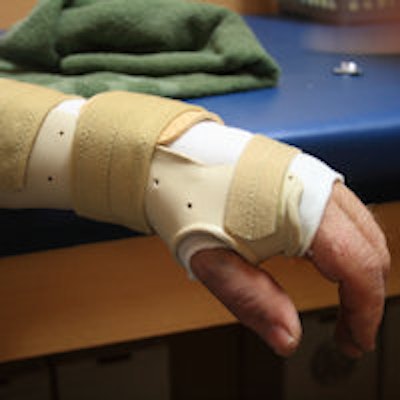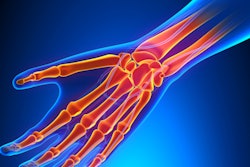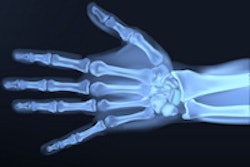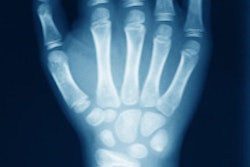
Conebeam CT (CBCT) is a highly effective, low-dose technique for detecting scaphoid fractures, and can demonstrate concomitant fractures that are notoriously difficult to see on radiographs, according to a prize-winning Belgian study.
Detection of clinically suspected scaphoid bone fractures using a dedicated CBCT scanner enables early treatment and avoids the need for unnecessary immobilization in patients without fracture, noted Dr. Luc De Beuckeleer and colleagues from the department of radiology, University Hospital of Antwerp, Edegem. The group presented the findings of a study involving 139 patients in an e-poster that received one of the three winners' awards presented at the 2014 annual meeting of the European Society of Musculoskeletal Radiology (ESSR), held in Riga, Latvia.
"The scaphoid is the most frequently injured carpal bone, mostly due to a fall on an outstretched hand. Scaphoid fractures are often occult on initial radiographs," they stated. "Since scaphoid fractures may be implicated by a process of nonunion with instability, avascular necrosis, and late osteoarthritis, patients with suspected fractures will be immobilized routinely, until (repeat) imaging confirms or denies the presence of a fracture. This approach will however result in needless immobilization in a number of patients, having a negative impact on their daily activity and representing a high economic cost."
This scenario prompted them to investigate the potential role of low-dose CBCT in the assessment of patients who sustained a trauma clinically suspicious for scaphoid fracture. The technique has been widely adopted for dental 3D-imaging since the late 1990s, and compared with multi-detector CT, it offers higher resolution with a relatively low radiation dose. Modern systems afford examinations in a seated or lying position, permitting high-resolution CBCT of other body parts, such as the wrist, elbow, foot, and ankle.
The researchers examined whether CBCT can identify supposedly occult scaphoid fractures, thereby enabling accurate treatment for fractures at risk of osteonecrosis (proximal pole fractures) or of nonunion on the one hand, and avoiding overtreatment in patients who definitely did not sustain a fracture on the other hand.
A total of 139 patients (80 men, 59 women; age range 7 to 83) who were clinically suspicious for scaphoid fracture were examined within six days after the event with radiographs, followed by a CBCT examination. A series of three standard projection views -- posteroanterior, lateral, and posteroanterior view with ulnar deviation -- were taken.
CBCT was performed on a NewTom 5G CBCT scanner (QR Srl, Verona, Italy). The patient sat behind the gantry, with his or her arm in a horizontal position through the gantry opening and the wrist and hand fixated in order to prevent motion artifacts. The anode voltage was a maximum 110 kV at 3 mA current, the measured field of view was 8 x 8 cm, and the scan time was about 7 seconds.
The CT images were generated by rotating an x-ray source around the wrist, creating a series of flat-panel detector radiographs with the patient sitting behind the gantry. This resulted in an axial dataset of 659 raw data images, according to De Beuckeleer et al. The reconstructed 3D-volume was displayed on a 19-inch screen, which was used to manage image acquisition and data processing/reformatting. Coronal, sagittal oblique, true sagittal, and axial orthogonal 1 mm slices were reconstructed and sent by DICOM communication to a PACS (Impax, Agfa Healthcare). All images were randomized and retrospectively reviewed, blinded to the other examination.
In 20 patients, a fracture seen on conventional radiographs was confirmed on CBCT. In 33 out of 89 patients (37%) who were initially scored negative on radiographs, at least one carpal fracture was detected on CBCT (16 scaphoid, five hamulus of the hamate, five trapezium, and one capitate, one lunate , one hamate, one trapezoid; and in three patients a combination of lunate, capitate trapezium, triquetral, or hamate fractures). Using CBCT, 37 fractures were detected in this subgroup that was initially interpreted as radiographically negative. A total of 16 of them (i.e., 18% of initially misdiagnosed fractures) were scaphoid fractures, representing so-called occult scaphoid fractures.
Besides detection of these fractures, CBCT enabled the prompt, optimal treatment to be chosen in these 16 patients with occult scaphoid fractures, wrote the authors.
"If not being examined with CBCT, all of these 89 patients would have undergone standard conservative treatment with casting and repeat radiographs in two weeks. This procedure however would have implied an unnecessary temporary immobilization in 56 out of these 89 patients with potential negative impact on professional activities and daily life," they added.
The same holds true in 27 out of 30 cases where radiographs were equivocal and in whom CBCT excluded a wrist fracture (i.e., in 90%). Only in three out of these 30 patients was a fracture of the trapezium and scaphoid found upon CBCT in respectively one and two cases, thereby enabling adequate treatment for these patients, but avoiding unnecessary casting and follow-up in 27 other patients.



















